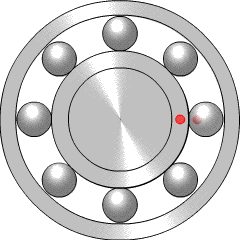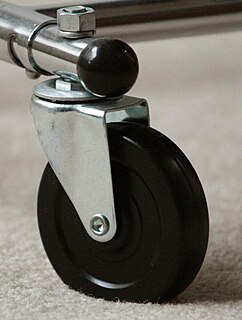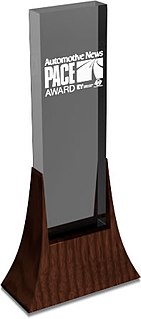
A skid loader, skid-steer loader or skidsteer is a small, rigid-frame, engine-powered machine with lift arms that can attach to a wide variety of labor-saving tools or attachments.

A ball bearing is a type of rolling-element bearing that uses balls to maintain the separation between the bearing races.
Fluid bearings are bearings in which the load is supported by a thin layer of rapidly moving pressurized liquid or gas between the bearing surfaces. Since there is no contact between the moving parts, there is no sliding friction, allowing fluid bearings to have lower friction, wear and vibration than many other types of bearings. Thus, it is possible for some fluid bearings to have near-zero wear if operated correctly.

A bearing is a machine element that constrains relative motion to only the desired motion, and reduces friction between moving parts. The design of the bearing may, for example, provide for free linear movement of the moving part or for free rotation around a fixed axis; or, it may prevent a motion by controlling the vectors of normal forces that bear on the moving parts. Most bearings facilitate the desired motion by minimizing friction. Bearings are classified broadly according to the type of operation, the motions allowed, or to the directions of the loads (forces) applied to the parts.

A compressor is a mechanical device that increases the pressure of a gas by reducing its volume. An air compressor is a specific type of gas compressor.

A magnetic bearing is a type of bearing that supports a load using magnetic levitation. Magnetic bearings support moving parts without physical contact. For instance, they are able to levitate a rotating shaft and permit relative motion with very low friction and no mechanical wear. Magnetic bearings support the highest speeds of any kind of bearing and have no maximum relative speed.

A plain bearing, or more commonly sliding contact bearing and slide bearing, is the simplest type of bearing, comprising just a bearing surface and no rolling elements. Therefore, the journal slides over the bearing surface. The simplest example of a plain bearing is a shaft rotating in a hole. A simple linear bearing can be a pair of flat surfaces designed to allow motion; e.g., a drawer and the slides it rests on or the ways on the bed of a lathe.

A jewel bearing is a plain bearing in which a metal spindle turns in a jewel-lined pivot hole. The hole is typically shaped like a torus and is slightly larger than the shaft diameter. The jewels are typically made from the mineral corundum, usually either synthetic sapphire or synthetic ruby. Jewel bearings are used in precision instruments where low friction, long life, and dimensional accuracy are important. Their largest use is in mechanical watches.

A rolling-element bearing, also known as a rolling bearing, is a bearing which carries a load by placing rolling elements between two bearing rings called races. The relative motion of the races causes the rolling elements to roll with very little rolling resistance and with little sliding.

A caster is an undriven wheel that is designed to be attached to the bottom of a larger object to enable that object to be moved.

Babbitt metal or bearing metal, is any of several alloys used for the bearing surface in a plain bearing.
A linear-motion bearing or linear slide is a bearing designed to provide free motion in one direction. There are many different types of linear motion bearings.

The PACE Award is an annual award from Automotive News. The focus of the award is an innovation (i) developed primarily by a supplier, (ii) that is new to the automotive industry, (iii) that is in use, and (iv) that "changes the rules of the game." Awards have been given for products, materials, processes, capital equipment, software and services. A panel of independent judges from industry, finance, research, and academia choose finalists from the initial applicants, make site visits to evaluate the innovation, and then gather to select winners, independent of the sponsors. Winners to date include suppliers from Japan, Korea, China, the US, Canada, Brazil, Germany, France, Italy, Poland and other European countries. Among the most awarded companies over the years are BorgWarner, Delphi Automotive, Federal-Mogul, Valeo and PPG Industries as well as Robert Bosch GmbH, Gentex Corporation, and Siemens.
Brinelling is the permanent indentation of a hard surface. It is named after the Brinell scale of hardness, in which a small ball is pushed against a hard surface at a preset level of force, and the depth and diameter of the mark indicates the Brinell hardness of the surface. Brinelling is permanent plastic deformation of a surface, and usually occurs while two surfaces in contact are stationary and the material yield strength has been exceeded. The brinelling is undesirable, as the parts often mate with other parts in very close proximity. The very small indentations can quickly lead to improper operation, such as chattering or excess vibration, which in turn can accelerate other forms of wear, such as spalling and ultimately, failure of the bearing.
A cam follower, also known as a track follower, is a specialized type of roller or needle bearing designed to follow cam lobe profiles. Cam followers come in a vast array of different configurations, however the most defining characteristic is how the cam follower mounts to its mating part; stud style cam followers use a stud while the yoke style has a hole through the middle.

The yaw bearing is the most crucial and cost intensive component of a yaw system found on modern horizontal axis wind turbines. The yaw bearing must cope with enormous static and dynamic loads and moments during the wind turbine operation, and provide smooth rotation characteristics for the orientation of the nacelle under all weather conditions. It has also to be corrosion and wear resistant and extremely long lasting. It should last for the service life of the wind turbine) while being cost effective.
Oilite is a brand of self-lubricating bearing that is made from metal alloys with pores that channel lubricants between the bearing itself and the shaft. It is manufactured from different types of material. Traditional Oilite is mostly made of copper with approximately 10% tin and up to 1% iron, while both Super Oilite and Super Oilite 16 are primarily made of iron with about 20% copper and, in the case of the latter, up to 1% graphite. Oilite is currently a registered trademark of Beemer Precision, Inc.
Shaft voltage occurs in electric motors and generators due to leakage, induction, or capacitive coupling with the windings of the motor. It can occur in motors powered by variable-frequency drives, as often used in heating, ventilation, air conditioning and refrigeration systems. DC machines may have leakage current from the armature windings that energizes the shaft. Currents due to shaft voltage causes deterioration of motor bearings, but can be prevented with a grounding brush on the shaft, grounding of the motor frame, insulation of the bearing supports, or shielding.

Air bearings are fluid bearings that use a thin film of pressurized gas to provide a low friction load-bearing interface between surfaces. The two surfaces do not touch, thus avoiding the traditional bearing-related problems of friction, wear, particulates, and lubricant handling, and offer distinct advantages in precision positioning, such as lacking backlash and static friction, as well as in high-speed applications. Space craft simulators now most often use air bearings and 3-D printers are now used to make air-bearing-based attitude simulators for CubeSat satellites.
Most of the terms listed in Wikipedia glossaries are already defined and explained within Wikipedia itself. However, glossaries like this one are useful for looking up, comparing and reviewing large numbers of terms together. You can help enhance this page by adding new terms or writing definitions for existing ones.













